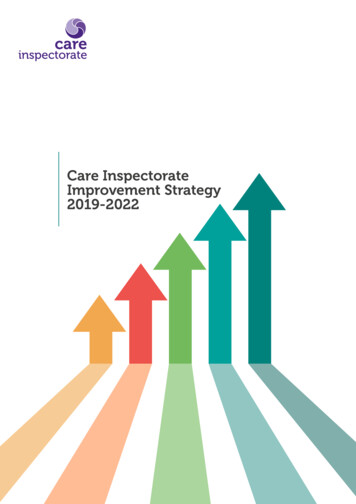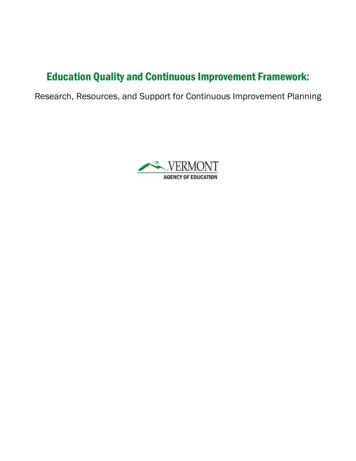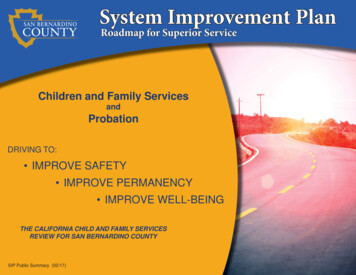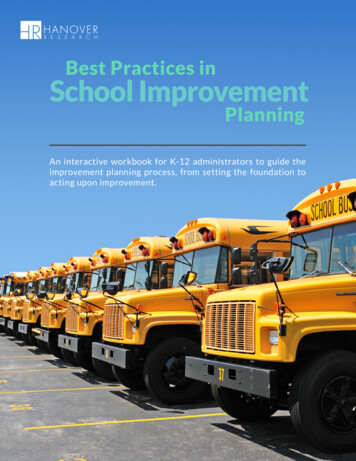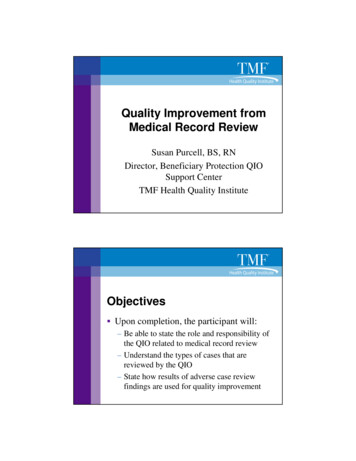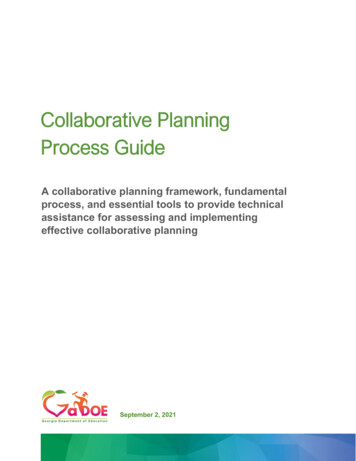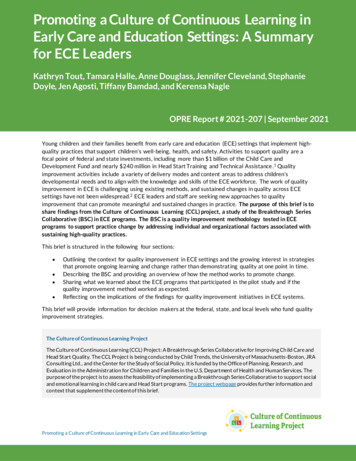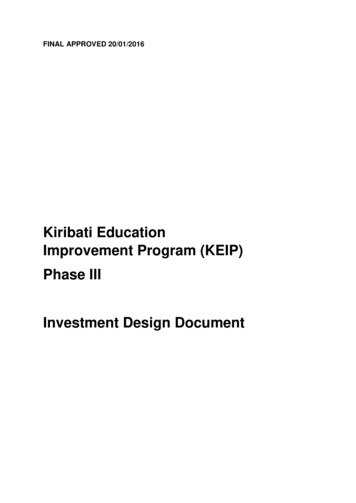
Transcription
FINAL APPROVED 20/01/2016Kiribati EducationImprovement Program (KEIP)Phase IIIInvestment Design Document
Table of contentsExecutive summary. 11The need for development of Kiribati’s human resources . 12Australia’s investment in education reform in Kiribati . 23Key design considerations . 24Problem analysis and program logic . 35Management and governance . 46Key risks. 5Analysis and strategic context . 578Strategic context . 57.1Geography . 57.2Poverty and disempowerment . 67.3The Kiribati Education Sector . 7Analysis of the development problem . 108.1The situation . 108.2The development problem . 108.3The causes of low outcomes . 118.4Improving learning and participation . 148.5What success would look like for the investment . 189Government reform priorities: the 2016-19 ESSP and KEIP Phase III alignment . 1910Lessons learned . 191110.1Lessons for learning . 1910.2Lessons for leadership . 2110.3Lessons for sustainability . 2210.4Lessons for community engagement . 22Rationale for Australia's engagement . 2311.1Interactions with other development partners and the private sector. 2411.2Innovative approaches . 26Investment description . 2712Logic and Expected Outcomes . 27i
13Theory of Change . 2814Monitoring and Evaluation . 30151614.1System Alignment . 3014.2Monitoring and Evaluation Focus . 3114.3A Focus on Learning Outcomes . 3214.4Further Developments . 34Australia's investment in KEIP Phase III . 3415.1KEIP Phase III Prioritisation . 3415.2End of Program Outcome 1: Increased learning outcomes for basic education for IKiribati girls and boys, including children with a disability . 3515.3End of Program Outcome 2: Effective and efficient decision making and delivery 46Resources . 51Implementation arrangements . 511718Management Arrangements . 5117.1The Kiribati Education Facility . 5217.2Role of government systems . 5217.3MoE management structure . 5217.4Reporting Requirements . 53Governance Arrangements . 5418.1Policy dialogue and the role of EPiK in the achievement of KEIP outputs . 5419Implementation Schedule . 5520Procurement Arrangements . 5621Sustainability . 5622Gender Empowerment . 5723Disability Inclusiveness . 5824Private Sector Engagement. 5925Risk Management and Safeguards . 60ii
AnnexesAnnex 1Basic Education Sector SummaryAnnex 2Map of KiribatiAnnex 3Theory of Change / Program Logic DiagramAnnex 4Implementation & Resource ScheduleAnnex 5Key Position DescriptionsAnnex 6Budget and Cost Estimates SummaryAnnex 7Monitoring & Evaluation FrameworkAnnex 8Risk Register and Safeguards SummaryAnnex 9ESSP 2016-19 Principles and GoalsAnnex 10Education Sector Public Financial Management AssessmentAnnex 11KEIP Phase III Design Terms of ReferenceAnnex 12KEIP Phase III Concept Noteiii
AcknowledgementsThe design for the Kiribati Education Improvement Program Phase III was managed by CoffeyInternational Development. The design team was led by Paul Tippett and included Dr Mary FearnleySander as the education advisor, and Dr Andrew Kibblewhite as the monitoring and evaluationadvisor. Tony Higgins undertook the Education Sector Public Financial Management Assessment.The design team was well supported by Rebecca Karlsson, the KEIP Project Manager and also LindaVasey, the KEIP Contractor Representative.Coffey and the design team wishes to thank the Kiribati Minister of Education, the Hon. MaereTekanene, her senior executive team and also the Ministry staff for the unstinting time they madeavailable for consultations and also for the quality of their inputs and insights. The many hours thatsenior Ministry of Education staff spent with the design team in identifying the priorities, and howdevelopment partner support could be best applied, was invaluable.Particular thanks are also due to Michael Hunt, Samantha Vallance, Florence O’Connor and theteam at DFAT’s Tarawa Post for their supportive guidance, leadership and facilitation throughoutthe design process.The design team is also grateful to Kaye Cox, the KEIP Phase II team leader, as well as the KEIPPhase II advisors and partners for their ongoing insights and briefings that are directly relevant toPhase III; and also to Antoine Barnaart, the Principal of the Kiribati Institute of Technology, for helpingmake contextual connections between junior secondary education and employability skills.Finally, the design team would like to acknowledge the contribution made to the quality of the KEIPPhase III design by the peer reviewers from DFAT’s Pacific, Education, Gender, Disability and Designareas, and by Barbara Thornton, independent reviewer; and Tony McGee, DFAT Pacific EducationAdvisor, for their invaluable technical inputs.iv
AbbreviationsAQEPAccess to Quality Education ProgramCCGCommunity Consultation GroupCCTCommunity Consultation TeamCDOCurriculum Development OfficerCDRCCurriculum Development and Resource CentreCOLCommonwealth of LearningDEODistrict Education OfficerDFAT(Australian) Department of Foreign Affairs and TradeDOPDivision Operational Plan (Ministry of Education)EACEducation Advisory CommitteeEAUExaminations and Assessment UnitEMISEducation Management Information SystemEOPOEnd of Program OutcomeEPiKEducation Partners in KiribatiESGBVEliminating Sexual and Gender Based ViolenceESPAEducation Strategic Planning AdviserESSPEducation Sector Strategic PlanFMUFacilities Management UnitGoAGovernment of AustraliaGoKGovernment of KiribatiGBVGender Based ViolenceGPEGlobal Partnership for EducationHODHead of Division (Ministry of Education)HRDHuman Resource DevelopmentIDDInvestment Design DocumentIEInclusive EducationIECIsland Education CoordinatorIMAInfrastructure Management AdviserISLPRInternational Second Language Proficiency RatingJSSJunior Secondary SchoolsKDPKiribati Development PlanKEFKiribati Education Facilityv
KEIPKiribati Education Improvement ProgramKELPKiribati English Language ProgramKELTKiribati English Language Test(K)EMIS(Kiribati) Education Management Information SystemKITKiribati Institute of TechnologyKTCKiribati Teachers CollegeLIELanguage in EducationLIMELearning Impact Monitoring and EvaluationLPIALanguage Policy Implementation AdviserM&EMonitoring and EvaluationMISAMinistry of Internal and Social AffairsMLHRDMinistry of Labour and Human Resource DevelopmentMLPIDMinistry of Line and Phoenix Islands DevelopmentMoEMinistry of EducationMOPMinistry (of Education) Operational PlanMoUMemorandum of UnderstandingNCAFNational Curriculum and Assessment FrameworkNCACNational Curriculum and Assessment CommitteeNEPONational Economic Planning OfficeNISNational Infrastructure StandardsPAPerformance AppraisalPFMPublic Financial ManagementPILNAPacific Islands Literacy and Numeracy AssessmentPMFPerformance Measurement FrameworkPPDPolicy, Planning and Development UnitPSOPublic Service OfficePSRPPrimary School Rehabilitation PlanRMRelationship ManagerSEOSenior Education OfficerSEMSSenior Education Management SpecialistSG1Senior Grade 1 (Head Teacher with island-wide responsibilities)SIPSchool Improvement PlanSIUSchool Improvement UnitSLSSSchool Leader Service StandardsSLSS-PASchool Leader Service Standards-Performance Appraisalvi
SMMSenior Management MeetingSSSenior Secondary (Schools)SPCSecretariat of the Pacific CommunitySTAShort-term Technical AdviserSTAKiStandardised Tests of Achievement for KiribatiSWApSector Wide ApproachTATechnical Assistance(T)PD(Teacher) Professional DevelopmentTPDFTeacher Professional Development FrameworkTSIMUTechnology Support and Information Management UnitTSS-PATeaching Service Standards-Performance AppraisalTTCTeacher Training Centre (Outer Islands)TVETTechnical Vocational Education and TrainingUNESCOUnited Nations Education, Science and Cultural OrganisationUSPUniversity of South PacificWASHWater, Sanitation and Hygienevii
Executive summary1 The need for development of Kiribati’s human resourcesIn the face of an uncertain future and limited options for promoting growth, the people of Kiribati are itsprime resource. The Government of Kiribati (GoK) envisages a skilled youth population able to competein international and regional labour markets. This would help diversify an economy with a narrowrevenue base. It would bring in revenue from remittances and enable the development of domestic1value-adding business, skills and networks, acquired through offshore training and experience . With agross domestic product per capita at AUD1,620 per annum and declining, Kiribati is one of the poorestcountries in the region.Poor quality of life is also an outcome of poverty, low levels of education and, in South Tarawa, the impactof overcrowding that is placing pressure upon the country’s environmental and social resources. There isvery high unemployment, among youth particularly. Approximately 20,000 people are employed andsupporting around 103,000 people. Social cohesion and stability are threatened by the associated strains.Gender violence levels are among the Pacific’s highest; women and girls with a disability are mostexposed to it.Kiribati's development plans have successively prioritised human resource development as "of paramount2importance in the development and future economic growth of the country". They have identified accessto relevant, quality education as the means to this human development. Their focus from 2008 has beenon acquisition of fundamental skills. A key objective of the Kiribati Development Plan 2012-15 was to3improve functional literacy and numeracy and provide access to skills development opportunities. TheMinistry’s 2016-19 Education Sector Strategic Plan (ESSP) continues to place emphasis on "the critical4importance of education for their life beyond school for all I-Kiribati young people".Disturbingly low achievement in national assessments, troubling patterns of non-participation in basiceducation, as well as the low participation of I-Kiribati in skilled work domestically (and offshore) indicatethe distance yet to be travelled in developing this human resource capacity.Large proportions of children of relevant school age groups are missing at every level of basic education.Issues include under-enrolment at initial intake into Year 1, an enrolment fluctuation over the primaryschool years that may indicate a pattern of drop out and return; and low retention up to the end of JuniorSecondary School (JSS). On average over the past five years, only 78% of the primary age group areenrolled, and only 79% of the primary enrolment survives from Year 1 into JSS.School survival rates also show a marked gender disparity. There are 27% of boys compared with 16% ofgirls lost from Year 1 through to JSS. This loss of boys in school continues into Senior Secondary (SS)and accelerates in the final year.The continued reform of the basic education sector can make a very positive and significant contribution toKiribati’s future.1Kiribati Development Plan 2012-15Kiribati Development Plan 2008-113Kiribati Development Plan 2012-15, p.214Kiribati Education Sector Strategic Plan 2016-2019 (draft), p.121
2 Australia’s investment in education reform in KiribatiThe nine-year Kiribati Education Improvement Program (KEIP) is the framework within whichAustralia and other development partners are supporting the Ministry of Education (MOE) toimplement its plans for education to support human resource development. KEIP was de signed to beimplemented in three phases.KEIP Phase I (2011-2012) was the enabling phase, setting up the legislative and policy frameworks fortransforming the quality of learning in basic education. KEIP Phase II (2013-2015) supported theimplementation of reforms at the school and classroom level across Years 1-4, and prepared for upperprimary. Steady progress has been made under KEIP Phases I and II, however there is still more to do inthe basic education sector.KEIP Phase III (2016-19) is intended to complete the primary reforms (Year 6) and extend them into thejunior secondary component of basic education. This third phase of KEIP has as its development goal:Young I-Kiribati finish basic education with the knowledge and skills to contribute to aproductive and resilient Kiribati community.The KEIP Phase III Concept Note is included as Annex 12. It is proposed that Australia invests AUD 34million in KEIP Phase III, over the next four years, to support the MoE to implement its basic educationreform program as set out in the Education Sector Strategic Plan 2016-19.3 Key design considerationsThe KEIP Phase III Design Terms of Reference are included as Annex 11. The investment design has beenshaped by three main influences. One is the importance of viewing KEIP as one continuous program,needing to use all of its nine years to consolidate and sustain transformative, systemic change. Thechanges most needing consolidation were included in the 2014 Independent Evaluation of KEIP Phase II. Akey one was early years’ learning improvement. Literacy and numeracy acquisition in the early years is thefoundation upon which later learning performance is built. Keeping the lower primary reforms in focus duringKEIP Phase III will also help promote continuity in the development of core skills in literacy and numeracy, asthe reforms work their way up to (and through) JSS.A second influence is recognition that while extension into junior secondary is the last step of a basiceducation intervention, junior secondary as a sub-sector is distinctively different from primary –particularly in Kiribati. Improving JSS involves dimensions additional to those of curriculum and teachingreform. For the majority of young people in Kiribati, JSS is the last stage of their formal education, and asthe endpoint, must deliver skills to better empower them economically and for life. Yet the current JSSsystem still belongs to an era when JSS was the academic ladder to Senior Secondary for those highperforming few. As the final stage of free, compulsory and universal basic education, the essentialchallenge of JSS is to position its graduates to access various pathways to work, skills and further study,and to help MoE articulate the key role that the JSS level of schooling should serve in Kiribati's humanresource development.The students in JSS are also different from those in the primary years. As adolescents they are forminggendered identities and the basis of their future gender relationships. In view of the scale of gender basedviolence in Kiribati, reforming the underlying values and behaviours that lead to adverse outcomes forwomen and girls is an important part of a JSS intervention. One of the most effective strategies for dealing5with issues of violence and discrimination in the Pacific is school education. This priority for JSS supports5DFAT 2012. Pacific Women Shaping Pacific Development Delivery Strategy2
the Government of Kiribati's (GoK) School Wellbeing program, designed to harness school education in6support of Kiribati's Family Peace Act against gender based violence in the community.The third influence is the Government of Kiribati Education Sector Strategic Plan (ESSP) for 2016-19,7informed by the recent Education Sector Analysis, which sees it as imperative for MoE to develop theprocesses to enable the Ministry leadership to maximise the organisational capacity that has been8developed. KEIP Phase III will support MoE's leadership particularly in respect of sectoral planning andsustaining the gains of KEIP.Strategically the KEIP Phase III design has also been influenced by the fact that, while this is the lastphase of the nine-year program, Australia has a long-term commitment to the supporting educationreform in Kiribati. JSS reforms will not be fully rolled out by the program’s end date of 2019. There will beneed for ongoing engagement from Australia, not only to complete the JSS reforms but also to consolidateand strengthen those transformational reforms that have been achieved in a relatively short space of time.The knowledge that Australia will continue its engagement beyond KEIP allows the reforms to be paced inways that facilitate capacity building and knowledge transfer, and for stakeholder expectations to beadjusted to the time required for improvements to manifest themselves.4 Problem analysis and program logicKEIP Phase III has defined the development problem as poor basic education learning outcomesconstraining the capacity of young I-Kiribati to develop productive and marketable skills. Situation analysisindicates that the fundamental causes of this situation lie in the GoK’s fiscal incapacity to adequatelyresource inclusive, quality basic education; insufficient know-how in some of technical and systemic fieldsfor MoE to be able to address the problem adequately on its own; and a community not yet sufficientlyengaged in supporting children’s learning. This complex situation exists alongside the political will, at alllevels, to bring about improvements. This is evidenced in MoE’s leadership of the reforms and the highlevels of compliance by schools and teachers.Consequently, Australian support will target the barriers that limit GoK ability to redress the problem:inadequate resourcing and technical capacity to bring about learning improvement that all I-Kiribatichildren can participate in. In this support, KEIP Phase III will be helping MoE realise the agenda of all thenine ESSP goals that relate to basic education.The logic of KEIP Phase III is to focus simultaneously on the following two end of program outcomes (EOPO).EOPO 1: Improved learning outcomes for basic education for I-Kiribati girls and boys, includingchildren with a disability.This EOPO will be attained by a logic of intervention that targets improving access, participation, retentionand quality of teaching and learning for all children. Interventions will target making the infrastructure andthe culture of schools conducive to learning, including providing supportive environments from theperspective of gender and for children with a disability. Interventions also will target making the curriculummore accessible, relevant and skilling.Extensive focus will be on developing teachers’ capacity to help every child learn, and to succeed in acurriculum that is delivered in English. The capacity of School principals, District Education Officers(DEOs) and Island Education Coordinators (IECs) will be developed as the means of sustaining learningin schools, and bringing communities to understand the importance of all children attending school andlearning, right to the end of Junior Secondary.6Republic of Kiribati 2014. School Wellbeing and Counselling Good Practice GuidelinesJim Matheson, Education in Kiribati: Can it be the peoples’ life jacket? An analysis of the Kiribati Education System,draft September 2015.8Kiribati Education Sector Strategic Plan 2016-19 (draft), p.573
EOPO 2: MoE effectively plans, resources and manages priority sector activities.The interventions in this pillar of KEIP Phase III focus on the processes of sector leadership. At theexecutive level KEIP Phase III will aim to institutionalise the cycle of evidence-based planning, budgeting,and the monitoring and evaluation (M&E) of progress that enables a sector plan to drive Ministry work.Key outcomes will be the establishment of an expenditure framework for the ESSP 2016-2019, thedevelopment of annual education reports and the practice of annual joint monitoring of progress againstthe ESSP, while feedback will inform the subsequent annual planning.At the middle management level, the interventions target improvement of systems for effective use of datafor improved service delivery (Policy, Planning and Development Unit and School Improvement Unit), andto enable the development of incentives for performance improvement.The analytical agenda at MoE has also been expanded, to provide more precise information on wherebarriers to access, learning and opportunities lie, and to be able to build knowledge in response to issuesarising through the monitoring of innovation and implementation.The Education Partners in Kiribati (EPiK) forum will play an important role as a platform forgovernment accountability through its enabling government, stakeholders and development partnersto share annual reports and monitoring against the ESSP. The EPiK will also provide a forum forcoordinated policy dialogue around an ESSP that, for the first time, encompasses the whole educationsector. This is an opportunity to develop EPiK's membership, to include partners important for the scope ofKEIP: the Ministry of Women Youth and Social Affairs, senior secondary church school representation(CEDAK), the teachers' union, the parents' association as well as existing partners. With Australia'ssupport to Kiribati also covering the Technical Vocational Education and Training (TVET) sector, it is inAustralia's interest to see the various education stakeholders recognise and address the connectionsbetween education subsectors.Policy development will be important in this final phase of KEIP, as means of sustaining the KEIP gains.The substance of this investment has been in capacity building and training. Future systemised provisionfor teacher development, underpinned by policy, needs to be made if the quality of teaching and learningalready attained is to endure.5 Management and governanceIn this third phase of KEIP, the delivery modality continues to be through the existing managing contractor.KEIP was originally tendered on the open market as a nine-year program (2011-2019), and the contractwith the existing managing contractor includes the option to extend the program for the final four years, tocover implementation of KEIP Phase III. It is anticipated that the approved KEIP Phase III InvestmentDesign Document will form the basis of a contractual negotiation between DFAT and the managingcontractor, to enable KEIP Phase III implementation to commence during the first quarter of 2016.The managing contractor implements the program through the Kiribati Education Facility (KEF), based atthe Ministry of Education. The KEF annual planning identifies the scope, nature and amount of supportavailable, thereby providing the MoE with support to respond flexibly to emerging priorities or lessonslearned. There is regular KEF financial reporting to DFAT against budget and expenditure, as well asperformance reporting and any exception reports as may be required.At this stage it is not intended to use MoE financial systems for implementation of KEIP Phase III. TheMarch 2015 assessment of the Kiribati Education Sector Public Financial Management Systems (seeAnnex 10) considered “the residual risks of channelling DFAT funds through GoK and MoE downstream9systems are not manageable in the short term”. This position will be reviewed following a strengthening ofthe financial systems.9Education Sector Public Financial Management Systems Assessment, March 2015, p. 28 (Annex 10)4
In this design, the assumption is made that Australian support will continue to fund the position ofEducation Strategic Planning Adviser (ESPA) to the MoE, an important position that sits outside the KEFaccountability framework, separate from the KEIP managing contractor. The ESPA position has supportedMoE's leadership of the reforms, and MoE’s development of its systems and policies. This ESPA positionremains very important in assisting the MoE senior executive in developing their strategic managementskills and in steering an EPiK process that is substantively engaged in supporting the MoE to achieve itsESSP 2016-2019 goals.As Kiribati's largest education donor and long trusted partner, Australia needs to play a leading role insupporting the EPiK to evolve into the main platform for policy and resource support for the ESSP.Support will be provided via the ESPA and also under KEIP, in relation to the monitoring and reporting ofachievements against the ESSP.6 Risk managementThe investment has been assessed as low risk overall. Each of the known risks and potential challengesto the success of KEIP Phase III has been assessed as being low to moderate (after mitigation treatment).The risk assessment has been informed by stakeholder consultation in the design process, as well as thesuccessful KEIP Phase II risk management experience of the DFAT, MoE and the managing contractor.Risks will be closely monitored throughout implementation and the Risk Register will be updated at leastsix-monthly.A Risk Register and Safeguards Summary is included as Annex 8.Analysis and strategic context7 Strategic context7.1GeographyKiribati is a remote Pacific Island state with a small population of 103,000 spread across four groups10(districts) of widely dispersed islands. The logistical and communication constraints are significant, withthe Line Islands group up to 3,000 kilometres away from South Tarawa, the centre of government. SeeAnnex 2: Map of Kiribati, which indicates the logistics and distances involved in providing basic services tothe small population across this dispersed country.These geographic and logistical constraints cannot be underestimated. Every aspect of developing andmanaging the basic educati
advisor. Tony Higgins undertook the Education Sector Public Financial Management Assessment. The design team was well supported by Rebecca Karlsson, the KEIP Project Manager and also Linda Vasey, the KEIP Contractor Representative. Coffey and the design team wishes to thank the Kiribati Minister of Education, the Hon. Maere

